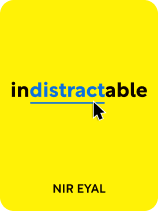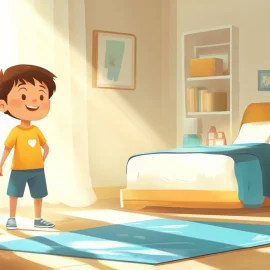

This article is an excerpt from the Shortform book guide to "Indistractable" by Nir Eyal. Shortform has the world's best summaries and analyses of books you should be reading.
Like this article? Sign up for a free trial here .
Do you get easily distracted by your phone, your coworkers, and other things around you? Do you blame external sources for your distracted behavior?
As it turns out, the root of distraction is inside you, also known as internal distractions. We often turn to distractions when we want to escape the discomforts of our lives but there are ways to fight back.
Here are three exercises that will help you push back against your internal distractions and stay focused on your tasks and goals.
Control Your Internal Distractions
Before you can control your internal distractions, you first need to understand what distractions are. Like many people, you probably believe that distraction is a product of the things around you such as your phone, different apps, or your chatty coworkers. In reality, the root of distraction is inside you.
Contrary to popular belief, humans aren’t motivated by punishment and reward—we’re motivated by freedom from discomfort. When we feel physical or mental discomfort, we naturally search for ways to escape it. These discomforts and escapes can take many forms, such as:
- The reality of difficult homework and the escape of scrolling social media
- The reality of marriage problems and the escape of building a farm on Animal Crossing
- The reality of work stress and the escape of Netflix binges
To get a handle on your internal distractions, you need to control their root cause—internal triggers.
Change Your Thinking Around Your Discomfort
No matter how good your life is, it’s likely you have a nagging sense of dissatisfaction or restlessness that drives you to look for “escapes.” What’s surprising about this feeling is that it’s completely normal—human evolution was driven by dissatisfaction. The desire to have more is what drives advancement and discovery.
Understanding that discomfort and dissatisfaction are normal is an essential part of becoming indistractable. Acknowledging your discomfort means you can examine it and think about how to use it, rather than suppressing it. The more you try to suppress an idea, the more aggressively it will invade your thoughts—as would happen if someone asked you not to think about a white bear.
Learning to control your internal triggers isn’t about learning not to think about them—it’s about learning to change how you think about them. Three exercises can help you examine and understand your internal triggers.
Exercise 1: Reflect on the Trigger
Rather than reacting to triggers with distraction, take four steps to meaningfully reflect on them and make more deliberate, traction-supporting choices.
Step 1: Identify the Trigger
When you find yourself about to switch over to a distracting activity, ask yourself: “What particular discomfort or feeling triggered me to do this?” Usually, you’ll find that the source is a negative emotion like anxiety, frustration, boredom, craving, incompetence, or lack of control.
- For example, you might be constantly checking your emails when you’re supposed to be working on difficult thesis revisions. Upon reflection, you find that you’re reacting to feeling frustrated and overwhelmed by escaping into the productive feeling of getting caught up on email.
Step 2: Note the Trigger
Keep a “distraction tracker” where you write down the details of your internal triggers—the time of day, who you were with, where you were, your emotions, what you were doing when you felt distracted, and the distracting action you took.
| Time | Where/Who | Activity | Feeling | Distracting Action |
| 2:15 | Home, alone | Studying | Overwhelmed and nervous | Reorganized bookcase |
| 3:45 | Starbucks, alone | Editing résumé | Frustrated, bored, unaccomplished | Scrolled through Instagram |
| 7:45 | Home, with family | Watching a movie | Anxious about upcoming exams | Started checking and organizing emails |
This step raises your awareness of your internal distraction patterns, helping you better control your actions in the future.
- For example, the next time you start feeling restless while studying, you know you’re about to click over to Reddit so you block the website for a few hours.
Step 3: Examine the Feeling
When you experience internal discomfort, commit to fully exploring all of your mental and physical feelings.
- For example, you might notice that when you feel internal discomfort your leg starts bouncing, you get a tightness in your chest, you start feeling restless, or you start humming to yourself. Once you give in to the internal distraction, you might feel relaxed, anxious in a different way, or equally restless.
The important part of this step is sticking with your feelings for as long as possible. This helps you accept and feel curious about your urges, instead of making them stronger by resisting them or trying to push them away.
Step 4: Look Out for Transitions
Distraction often crops up during transitional moments, when your brain is already in the process of shifting gears from one activity to another. In these moments, you usually think you’ll do something “just for a moment” while you shift gears, but your brain has other plans and hooks onto this new activity.
- This might look like sending a message to a friend and opening up Tumblr while you wait for their reply or going to the kitchen for a snack and scrolling through Instagram while you’re at it—only to find yourself still scrolling 30 minutes later back at your desk.
Try adopting a 10-minute rule to avoid latching onto the wrong activity in a moment of transition. Whenever you’re in one of these moments and feel the urge to grab your phone, open a new website, or distract yourself, tell yourself, “Okay, I’ll do that in 10 minutes.” Often, when those 10 minutes are up, you’re already deep into another, more productive task and have forgotten your urge.
- Psychologists call this “surfing the urge”—when the desire to distract comes up, you acknowledge it and commit to “surfing” on the feelings rather than diving into them or pushing them elsewhere.
Exercise 2: Reframe the Situation
The second way to harness your discomfort’s power is rethinking the situation you’re in and finding a way to make it fun.
“Fun” doesn’t always feel good—it often feels like challenge, discovery, or most importantly, freedom from discomfort. Making your situation engaging decreases internal triggers such as boredom and frustration, which curbs your urge to escape into distracting behaviors.
How to Create More Fun
Creating fun doesn’t require you to run away from the situation by switching to a new activity or to add elements to it like points or friends. Rather, it requires that you dive deeper to discover new information, perspectives, and challenges within the situation. When you manipulate a familiar situation to give it a sense of novelty, challenge, or excitement, you reframe your effort or concentration as “play,” making you feel more focused and engaged.
1) Dive deeper: Focus intently on the situation, break it down into its smallest elements, and learn as much about each element as you can.
- For example, if you’re bored with your job at a coffee shop, think about making the perfect latté. This requires learning about different types of espresso, the cream content of different types of milk, the outcome of various steaming temperatures, and so on.
2) Create play: Come up with different challenges—these should include different types of limitations because working within constraints sparks creativity and engagement.
- For example, if you have several essays to write, you might aim to write 3,000 words every day or set time limits to beat.
(Shortform note: Read our summary of How to Stop Worrying and Start Living to learn more about the benefits of finding ways to make your work interesting.)
Exercise 3: Rethink Who You Are
It’s commonly thought that people have a finite amount of willpower. Once it’s used up, you have to wait until your “tank” is full again. Many people use this idea to excuse unhealthy behaviors after class or work, such as vegging out on the couch in front of Netflix. However, scientists have recently found that willpower depletion isn’t real. Your willpower isn’t running out—rather your belief it’s running out fuels defeated behaviors.
Willpower isn’t a resource so much as an emotion—it comes and goes depending on internal and external circumstances, and can be managed and controlled with reflection and practice.
- Imagine you’re working on an overwhelming project and are feeling low on motivation. If you thought of willpower as a resource, you might give up because you “need a break.” On the other hand, if you think of willpower as an emotion, you find a way to manage it in that moment, such as completing a small or easy part of the project to get a boost in motivation.
Pay Attention to Labels
In addition to thinking about your willpower the right way, pay attention to the way you label yourself. When you label yourself a certain way—for example, “easily distracted” or “impulsive”—your behavior becomes more aligned with that label. This works positively, too: Calling yourself “focused” or “indistractable” will prompt focused, indistractable behaviors.
This means that it’s especially important to be self-compassionate when you experience failure or setbacks. By chastising yourself or calling yourself a failure, you create greater internal discomfort which translates into more distracting habits.
- One way that many people train themselves to be more self-compassionate is by talking to themselves as they’d talk to one of their friends—we’re naturally kinder with others than with ourselves, focusing on what went right and seeing the situation more objectively.

———End of Preview———
Like what you just read? Read the rest of the world's best book summary and analysis of Nir Eyal's "Indistractable" at Shortform .
Here's what you'll find in our full Indistractable summary :
- How to become indistractable in a world full of distractions
- Why your schedule should be based on your values instead of tasks
- How to start driving your life instead of letting its distractions drive you






